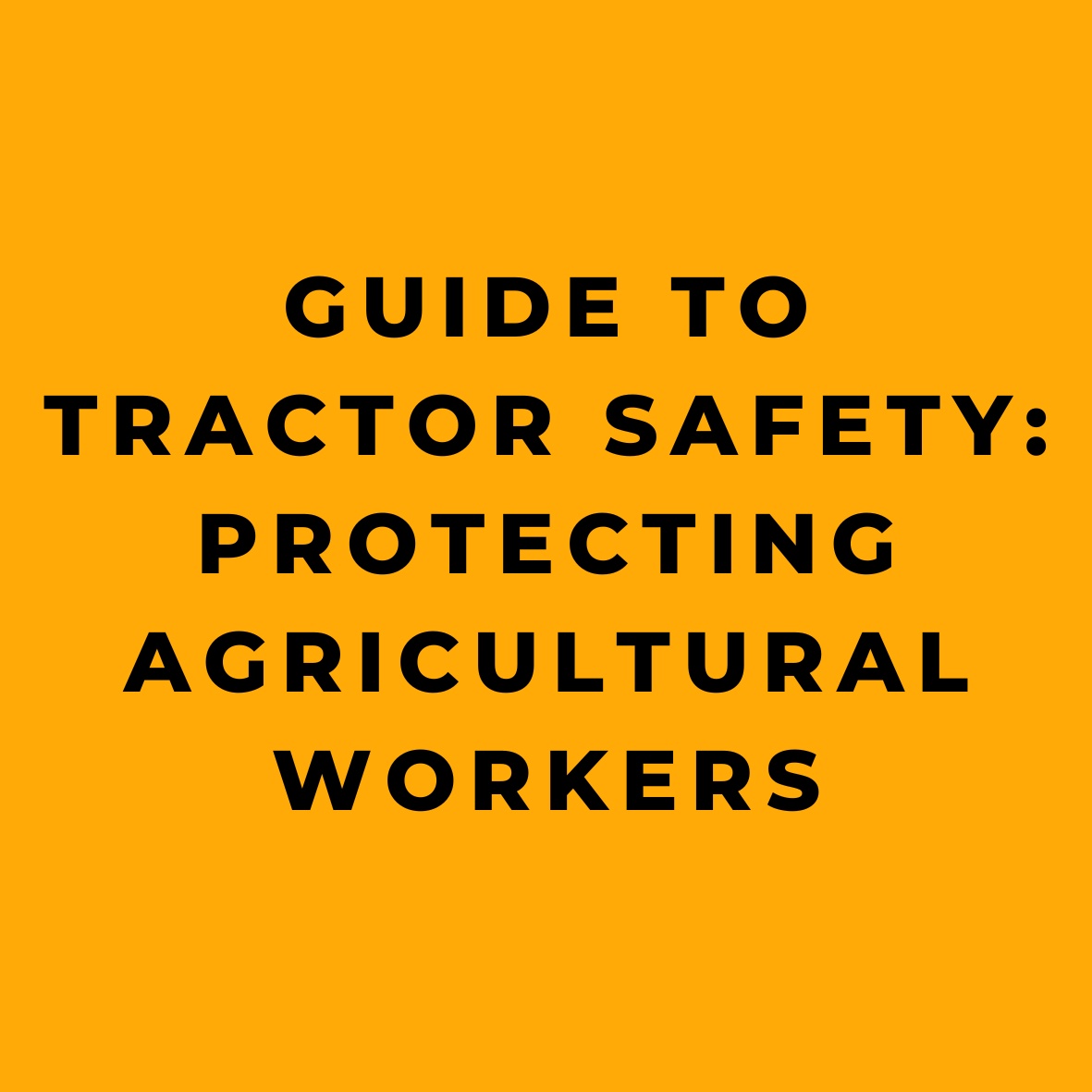I’m here to chat with you about keeping our hardworking agricultural workers safe from tractor hazards. You know, farming is a tough job, and tractors are mighty useful machines, but they can be dangerous if not handled properly. So, let’s dive right in and discuss some safety tips to protect our friends in the field.
Overturns
Tractor Troubles and Tumbles: You may not believe it, but most farmworker injuries and deaths come from tractor incidents like overturns, runovers, power take-off systems, and accidental contact with attachments. Employers need to make sure everyone stays safe on the job, so I’m gonna share some wisdom on these hazards and how to keep tractor operators protected.
Now, tractor overturns are a big problem in the agriculture industry. I’m talking about 130 deaths per year, friends. Most of the time, these tractors turn on their side or tip over backward, and it all happens so fast that the poor operator doesn’t have a chance to get clear.
Roll-over Protective Structures (ROPS)
Now, tractors can be safe if you treat ’em right. But if they’re old, run-down, missing safety features, or driven recklessly, well, that’s when things can go south. So, let’s talk about roll-over protective structures (ROPS) and seat belts.
ROPS and Seatbelt Requirements
ROPS and Seatbelt Savvy: If a tractor’s got a ROPS and the operator’s wearin’ a seatbelt, the chances of surviving an overturn without serious injury are pretty darn good. A ROPS is like a roll bar or cage frame that forms a protective zone around the operator in case the tractor tips. And to keep from being tossed out of the tractor, operators need to buckle up.
Qualified dealers can add a ROPS and seatbelt system to older tractor models. And the folks at the National Institute for Occupational Safety and Health have a nifty program called the Cost-Effective Rollover Protective Structure Program (CROPS) to help with tractors that don’t have commercially available ROPS.
Now, there are some rules about ROPS and seatbelts. Agricultural tractors with over 20 horsepower made after October 25, 1976, need to have ROPS. And every tractor with a ROPS needs a seatbelt. Employers have to make sure everyone’s using those seatbelts properly and tightening them up to stay within that protective ROPS area.
For those agricultural tractors with over 20 horsepower made after October 25, 1976:
- They’re required to have ROPS (1928.51(b)(1)).
- If there’s a ROPS, it’s gotta have a seat belt.
- Make sure each operator buckles up properly.
- Employers, be sure your operators tighten their seat belts, so they’re snug within the ROPS safety zone.
Now, when it comes to tractor operator training, here’s what employers need to cover initially and at least once a year (29 CFR 1928.51(d)):
- Fasten those seat belts good ‘n tight (for tractors with rollover protection).
- Whenever you can, steer clear of ditches, embankments, and holes.
- Avoid slopes that are too steep for safe driving.
- Slow ‘er down when turning or crossig’ slopes and on rough, slick, or muddy terrain.
- Keep your tractor runnin’ smooth—no jerky turns, starts, or stops.
- Keep your eyes peeled, especially at row ends, on roads, and around trees
Power Take-Off (PTO) Shafts
Power Take-Off (PTO) Shaft Safety: PTO shafts let farmworkers use the tractor’s engine power to drive all sorts of machines and implements. They’re mighty useful, but they can also be dangerous. Operators and workers can come into contact with both unprotected and protected PTOs. Employers gotta keep their workers safe from hazards created by a rotating PTO, and make sure the PTO guard is always in place. If the guard’s missing or damaged, it’s time for a new one.
Employers should train farmworkers on safe operation and servicing of equipment with PTOs, both at the start and at least once a year. This includes guarding PTOs with a master shield or other protective covering, stopping the engine and disconnecting the power source before servicing the equipment, keeping all guards in place during operation, and making sure everyone’s clear of the machine before starting the engine and engaging the PTO shaft’s selector switch. Long hair and loose clothing can get caught in a rotating PTO shaft, so tie your hair back and avoid baggy clothes.
It’s a good idea not to work alone around PTO-driven machinery. If someone gets entangled, a coworker might be able to stop the PTO shaft in time to prevent a more serious injury or even death.
Here’s an itemized list of things employers and workers need to know:
- PTOs are great, but they can also be risky. Make sure your workers stay safe.
- Keep an eye on that PTO shaft and make sure the guard is always in place.
- If a PTO guard is missing or damaged, replace it pronto.
- Train your workers on the safe operation and servicing of all equipment, including PTOs, initially and at least once a year (1928.57(a)(6)(i)).
- Guard all PTOs, whether they’re rear, mid-, or side-mounted, with a master shield or other protective gear (1928.57(b)(1)(i)).
- Before workin’ on equipment, stop the engine, disconnect the power, and wait for the PTO shaft to stop. If the machine needs to run for servicing, train workers on proper safety steps (1928.57(a)(6)(iii)).
- Keep all guards in place when the machine’s runnin’ (1928.57(a)(6)(i)).
- Make sure everyone’s clear of the machine before starting the tractor and engaging the PTO shaft selector switch (1928.57(b)(6)(iv)). Keep long hair tied back and avoid loose clothes, ’cause that PTO shaft can catch ’em.
- If you can, have a buddy around when workin’ with PTO-driven machinery. If somethin’ goes wrong, they might just save your life.
And remember, in 34 states, if your tractor and its towed attachment are movin’ 25 mph or slower, you gotta display an SMV emblem on the rear.
Tractor Operator Training
Trainin’ Time for Tractor Operators: To reduce tractor incidents, it’s important for employers to train their tractor operators. They need to learn how to follow the tractor’s operating instructions, say no to riders (unless there’s a seat and seatbelt for each of ’em), hitch only to the draw bar and hitch points, and set the brakes and hand brake when the tractor’s stopped for more than a few seconds. And of course, operators need experience and knowledge to handle the tractor safely.
Tractor operator training can make a world of difference in keepin’ everyone safe out there. Employers, here’s the same list in an itemized form of what you should teach your tractor operators:
- Follow the tractor’s operatin’ instructions to the letter.
- Don’t let anyone hitch a ride, unless there’s a proper seat and seat belt for ’em.
- Always hitch to the draw bar and hitch points, and nothin’ else.
- Set the brakes and hand brake, if you’ve got one, when the tractor’s parked for more than a moment.
- Make sure your operators have the experience and know-how to handle that tractor like a pro.
- By stickin’ to these guidelines, we can all help reduce tractor incidents and keep everyone safe.
Emergency Planning and Preparedness
Emergency Planning and Preparedness: Accidents can happen far from hospitals and emergency medical facilities, and most employers aren’t equipped to handle these injuries. Since treatment facilities aren’t usually close by, employers should develop an emergency action plan, designate an emergency staging area, train tractor operators on emergency response, and equip tractors with first-aid kits and working fire extinguishers. Agricultural first-aid kits should have items like gauze, splints, ice packs, surgical tape, disposable gloves, eye patches, burn dressings, and a first-aid instruction booklet.
In case of emergency, call local first responders or 911. Report your name, location, the nature of the emergency, and where workers can be reached. Keep in touch with tractor operators who work alone or in remote areas.
Workers’ Rights
Workers got the right to work in conditions that don’t put ’em at risk of serious harm. They should receive information and training about workplace hazards and how to prevent ’em, in a language they can understand. They also have the right to review work-related injury and illness records, file a complaint with OSHA if they believe there’s a serious hazard or if their employer ain’t following OSHA’s rules, and exercise their rights under the law without retaliation.
General Safety Precautions
Make sure operators and workers know their farm machinery well, especially equipment used only a few days a year, like combines and cotton harvesters. Conduct preoperational safety checks, review proper operating procedures, and keep tractor safety decals and stickers in good shape. Operators should be familiar with the ground where the tractor will be used, and keep an eye out for ditches, uneven terrain, and bystanders. Keep children away from tractors and their implements—kids and tractors just don’t mix. When startin’ or operating a tractor indoors, make sure there’s enough ventilation to prevent carbon monoxide buildup. Use exhaust fans if you got ’em, and if not, leave the doors open.
Here’s the same list in itemized form, and described in a little greater detail:
- Inspections and review: Make sure operators and workers know their machinery inside and out, especially for equipment used only a few days a year. Harvestin’ gear like combines and cotton harvesters need special attention.
- Safety checks: Perform preoperational safety checks, review proper procedures, and keep those safety decals and stickers in good shape.
- Be aware: Get operators familiar with the terrain and keep an eye out for ditches, uneven ground, and folks nearby.
- Children: Keep the young’uns away from tractors and their implements. Tractors are no place for kids.
- Indoor safety: Avoid carbon monoxide buildup by providin’ proper ventilation when runnin’ tractors indoors. Use exhaust fans or keep doors open if fans aren’t available.
- Highway safety: Train operators to steer clear of highways durin’ busy times, poor visibility, nighttime, or bad weather. Keep your tractors and towed equipment well-lit and marked. Consider usin’ emergency flashers and an escort vehicle for extra visibility. Don’t forget a clean, visible slow-moving vehicle (SMV) emblem on the rear – it’s required in 34 states for tractors and towed attachments travelin’ 25 mph or slower. Check your local regulations for SMV requirements.
By following these guidelines, we can help keep everyone safe on the farm and on the road.
Highway Safety
Train tractor operators to avoid highways during busy times, poor visibility, nighttime, or bad weather. Make sure tractors and towed equipment have proper lighting and markings, and follow transportation regulations. Operators should consider using emergency flashers and an escort vehicle to make the tractor more visible. A clean, visible, unfaded slow-moving vehicle (SMV) emblem should be attached to the rear of the tractor. In 34 states, SMV emblems are required on the rear of tractors and towed attachments going 25 mph or slower. Check your state highway regulations to see if your area requires an SMV emblem.
Conclusion
Keeping our hardworking agricultural workers safe is a top priority. By being aware of tractor hazards, following proper safety measures, and providing the right training, we can significantly reduce the risk of accidents on the farm. Let’s work together to make sure our fields stay safe and productive for everyone involved. Remember, a well-informed and cautious approach to tractor operation goes a long way in protecting lives and livelihoods.
If you got questions or need help, contact your nearest OSHA office, visit www.osha.gov, or call 1-800-321-OSHA (6742), TTY 1-877-889-5627. For more information on agricultural safety, visit OSHA’s Safety and Health Topics Agricultural Operations website at https://www.osha.gov/agricultural-operations.
And that’s a wrap!
References:










